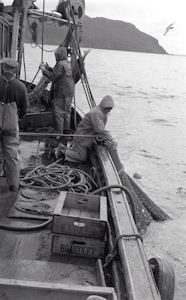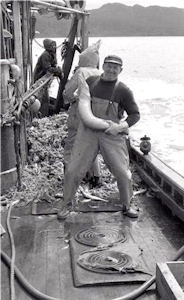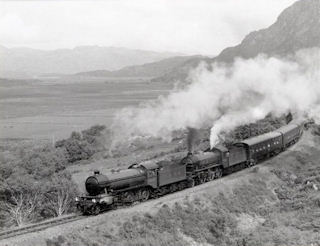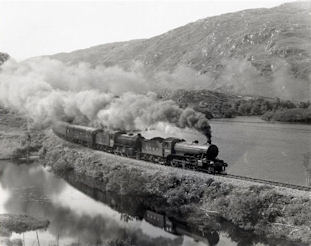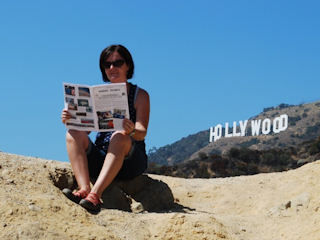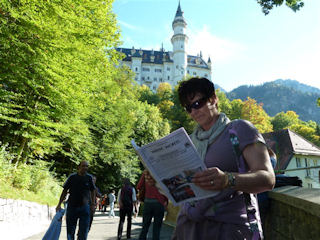WEST WORD
COMMUNITY NEWSPAPER OF THE YEAR 2005 & 2008
Community paper for Mallaig, Morar, Arisaig, Lochailort, Glenfinnan
Glenuig, Knoydart and the Small Isles
List of Issues online
|
November 2010 Issue
Happy Birthday to West Word 16 years old this issue!!!
Contents of the online version:
Top stories
Monthly news from Muck, Canna, Rum, Eigg, Arisaig
Crofting Roundup, Harbour news, Birdwatch
On and off the rails
Local Genealogy
Letters, e-mails and comments are welcome.
Contact Details & How to Subscribe to the Paper
Sign our Guestbook
All photos are copyright either of the individual photographers or West Word.
Not to be reproduced without permission.
|
LIFEBOAT SAVES COASTER
Mallaig Lifeboat crew endured a ten hour marathon call in horrendous weather conditions to save the 1300 tonne coaster Red Duchess off the Isle of Rum on Tuesday 2nd November 2010.
'There's no doubt the coaster would have gone ashore on Rum' said Mallaig Lifeboat Coxswain Michael Ian Currie. 'In the time between the call out and the lifeboat arriving on scene the Red Duchess - a 76m coaster laden with a cargo of coal - had drifted to within two miles of the island. The weather was atrocious but we got a tow rope aboard her stern, pulled her round into the wind and got her heading towards the open water of Rum Sound.'
However this was just the start of a gruelling six hour shift as the lifeboat, awaiting the arrival of the tug Anglian Prince, kept the coaster in tow - an extremely difficult task in storm force WSW winds gusting at 50mph, driving rain and five metre swell.
At 18:00hrs the Anglian Prince arrived on scene just as the tow line between the coaster and the Lifeboat snapped. The same thing happened when the first tow line between the Anglian Prince and the Red Duchess parted so while the tug retrieved the wire and re-set the tow line the Lifeboat, once again, came to the rescue of the coaster, reconnecting a tow line to the stern of the Red Duchess and bringing her round a mile or so from the shore.
Thirty minutes later the Anglian Prince established a second tow rope on board the coaster and set off for Stornoway
Mallaig Lifeboat returned to port eleven hours after being called out.
|
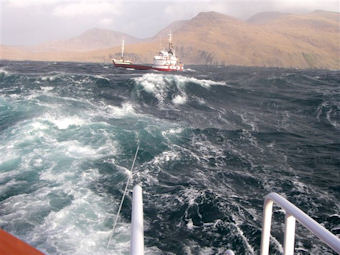
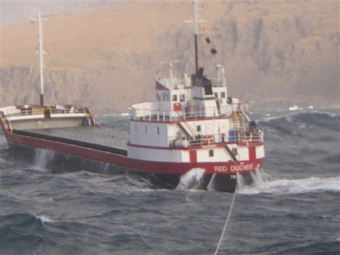
|
FUEL SPILLAGES - A830 FORT WILLIAM TO MALLAIG ROAD
Following an increase of reports of fuel spillages on the A830 Fort William to Mallaig public road the Police at Mallaig are making enquiry to establish if this is linked to a single vehicle or vehicles. Sergeant Nick MacRae based at Mallaig has requested that should any motorists suffer any problems or accidents due to what they believe to be fuel on the road, then they are requested to report the matter to Mallaig Police Station on 01687 462177.
Sergeant MacRae further asks that all motorists using the A830, from hauliers to private car owners check that their vehicles are not leaking fuel or fluids onto the road and are in a roadworthy condition.
YACHTING FACILITY FOR MALLAIG
With the funding package now agreed and all legislative/planning issues either addressed or in their final phase Mallaig Harbour can finally publish their plans for the creation of a yachting facility at the port.
There are two main differences to the draft plans issued last August. Due to funding constraints there will be no East Bay Slipway but the main change concerns the shore access/egress point. After discussions with Nevis Estates and Highland Council Roads Department it has been agreed to create the landing point near to the old Lifeboat steps on the south shore of the inner bay.
Rock to create the landing point will be obtained locally via Nevis Estate and in doing so the road access to Mallaig Vaig will be improved.
Work will start on the dredging aspect of the development on Monday 8th November and other aspects of the project will follow on over the winter with the proposed completion date being May 2011.
|
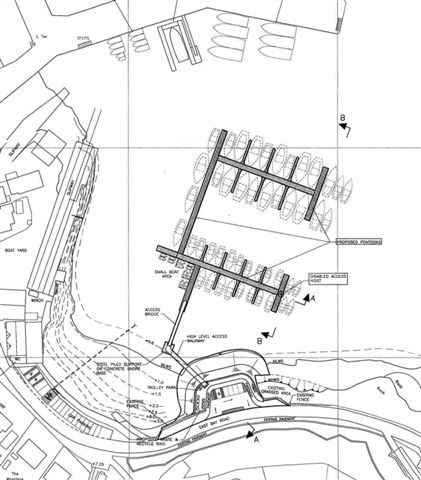 |
The following is set to occur over the winter 2010/11:
- Lifting of all existing moorings;
- Dredging of inner harbour to suitable depths;
- A pontoon system providing up to 45 dedicated yacht berths, up to 20 small boat berths, and up to 20 additional yacht berths by rafting;
- A bridge/walkway from the pontoons onto the shore;
- Swing moorings to accommodate visiting yachts at busy periods;
- Disabled hoist for people of limited mobility.
Harbour Secretary Robert MacMillan said 'The estimated cost of the Project is just shy of £800,000 and we are indebted to Sail West, Highlands & Islands Enterprise and The Highland Council for their financial input into the Project. Without them the development could not go ahead.
'With the dredging contract due to start soon and adverts placed in the Belfast Telegraph, The Oban Times and Irish Governments e-tenders website www.etenders.gov.ie seeking contractors for the Pontoon aspect of the works and also the Shoreworks we are certainly making progress now after a fraught last 2 to 3 months'.
It is the intention of the Authority to hold a public meeting soon to display plans and obtain feedback from local harbour users on the way ahead. In the meantime plans can be viewed at the Harbour Office.
ISLE OF MUCK
On 11th October Ewen with his JCB taking advantage of the fine dry weather, cut the first turf of our new hall. It was great to see a start at last and though the committee are still struggling to get the building within budget the gap is now very narrow and should be closed soon. One side effect of all this delay is that construction is likely to continue well into the summer when accommodation is in short supply already.
The new water scheme is finished with large black tanks in several locations ensuring that never again will we run out that vital commodity. Everyone must be very thankful that we were not forced to add chlorine!
And now Orkney. We (Jenny, Rosie and myself) visited Skara Brae a fragment of a Neolithic housing estate which is Orkney's top visitor attraction and is beautifully maintained by Historic Scotland. Almost as impressive, grazing on the dunes to the right were large white Charolais cows while on the left seven Angus bulls were quietly chewing the cud. For Orkney is a land of cattle and with 29,000 cows has the highest density of beef cattle in the world. And as most of the cattle are finished as beef at some times of the year numbers are more than double that. Marks and Spencer are major buyers of Orkney Angus beef. The whole island apart from the few hills is green and on none of the farms did I see any wasted grass and most had at least one field of barley - around 10 000 acres in all. Impressive farming!
Next month: David and Goliath on Orkney - the story of Pentland Ferries.
That is about all this month and hopefully by December I will have lots of better news for you.
Lawrence MacEwen
ISLE OF CANNA
A very interesting and exciting few months have now passed here on Canna with loads happening and many visitors coming and going. The fine weather of early September saw the National Trust for Scotland Patrons Club pay a visit. Checking on progress at the MacIssacs renovation and extension project which they had kindly provided funding for and getting around the many places of interest here on Canna. The culmination of this visit was the reception given by NTS staff at Canna House where most of the Community joined with the Patrons club in a celebration following in the tradition set by Dr. John Lorne Campbell and his wife Margaret Faye Shaw. The house resounded to the excellent singing in Gaelic of Anne Martin from Skye and a performance by the local children also in Gaelic ending what was an emotional evening for many who had known and experienced the Hebridean hospitality offered in Canna House by Mr and Mrs Campbell over the years they were alive. A special mention must go to Aart and Amanda of the Gillhe Brighde Restaurant for the excellent catering over the 3 day visit and to all members of the Community who ably assisted in making the trip a memorable one.
It's also been a very busy time for the National Trust for Scotland on the farm with the hard work of Geraldine and Murdo paying great reward at the sales. Canna lambs sold an average price of £52, with cast ewes getting £96 and gimmers £100. Calves recently averaged at £475. With the majority of the island of Canna given to farming these prices are testimony to the dedication of Geraldine and Murdo whose excellent farm management skills are integrated with the conservational skills of the NTS providing a unique Hebridean farming environment.
A recent fungi and lichen survey was carried out on the island in partnership with the Royal Botanic Gardens Edinburgh and the British Trust for Conservation Volunteers which was part funded by SNH. Identifying the many species of fungi and lichen was no small task and we await the results of the study with interest. The NTS gardener Neil Baker was also very interested in the lichen growths noted on the trees of Canna House Gardens. With Canna House Gardens now open to the public Neil provides excellent guided tours of the grounds by appointment.
The MacIssacs renovation and extension project is now nearing completion and the NTS via the Canna Community Association have advertised for a new residency. It's hoped that a new family will soon be welcomed to the island to take up a tenancy of the property adding to the small but growing population on the island.
Some good news to end with was the return to work of the National Trust for Scotland Canna House archivist Magda Sagarzazu, following a brief illness. Great to have the Basque spirit and cheerful smile back on Canna. Lastly all on Canna would like to wish Mairead, the daughter of NTS caretaker Winnie MacKinnon the very best of luck in her new role as an Au Pair near Paris, France. We are all sure that she will do very well. Bon Voyage a' Mhairead.
Stiubhart Connor
(Stiubhart moved to Canna in August as the first 'live-in' manager employed by the National Trust for Scotland. We are delighted that he has agreed to send West Word regular articles about life on the island.)
ISLE OF RUM
Here comes winter. We have had loads of rain and the burns are raging. Mike the Ranger is organising a community wildlife garden near the village hall where some old sheds have been removed. We will hopefully get some before and after photos for the West Word.
We say goodbye to Claire Dunn who has been working at the castle since January. We will miss you Claire! There is a new chef at the castle called Rachel and she has already created some delicious dishes. She has been living in Columbia for a number of years so we are hoping to get some Spanish lessons. We also say hello to a new castle staff member Hywel.
We are having a Halloween party and bonfire night which will be a great way to finish the season. Some upcoming birthdays are baby Jocelyn who is one year old on the 20th of November and Nell will be eleven on the 9th of December - Happy Birthdays!
George McMillan
ISLE OF EIGG
October has been a busy month for birthdays on Eigg, starting with Peggy Kirk, our beloved Eigg matriarch, who celebrated her 80th birthday on 8 October 2010. Peggy is from South Uist and as a birthday treat, her daughter Fiona arranged a party at the Royal Hotel in Oban where Peggy's brother Patrick and sister Bella who still live in Uist, could join in along with their families and with Maryflora who lives in Mallaig and Katie who lives in Glasgow. Quite a numerous gathering indeed, which left the island almost half empty with Kirks and Carrs and many of Peggy's Eigg friends Oban bound. Peggy was very pleased to have her picture taken with almost all her 16 grandchildren surrounding her (Greg is still in Vietnam and Calum could not make it) and was very pleased with all her John Lewis vouchers!
As to Wes Fyffe, who has now reached the age where he can take it easy, we can vouch that he still has retained some of his old sparkle, as attested by his wellie boot performance, and the way he continued celebrating for three days in a row, helped by the arrival of Angus Grant after his Shooglenifty gig in Glenuig it has to be said. However, as he now has broken his ankle, he will have to really take it easy...
Meanwhile the sileage has been safely baled in those few warm October days that almost let us believe we had an Indian summer. The weather helped to have a good turn out for our two history society outings to 5 Pennies and the Braes of Kildonnan as part of the Highland Archaeology fortnight, and it was heartening to see so many younger people showing interest in Eigg history.
But with 25 waxwings descending on Galmisdale to feast on the cotoneaster before heading south and a few Brent geese arriving from Siberia, autumn gales followed (preventing our long awaited butchery course from taking place, which was annoying) and we have now truly settled in the season of the dark winter nights and wet and windy days. There was mercifully less wind and rain on Hallowe'en for the number of cats, ghosties and witches that went guising from Cleadale to the pier where games were organised and a contest set for the best cross-dresser on the island. We are pleased to report that Sue Kirk beat George and Colin Carr, Maryanne McIntyre and Robert Hamil to the first prize.
Meanwhile we really should award a prize to Eddie Scott whose efforts to save the native bluebells have been celebrated in the media recently (you can order a packet of Eddie's certified blue bells seeds from Eigg shop), and another to Prof Ian Stuart for his brilliant "Lansdscape of Scotland" series which featured Eigg on the third episode which concentrated on the impact of depopulation on the land, although sadly the footage filmed by fixing a camera on Ewen's bike was not used! And Eigg being nominated for the Spirit of Scotland award, Westword readers may even win a prize themselves if they enter their vote for Eigg on http://www.glenfiddich.co.uk/news-events/glenfiddich-spirit-of-scotland-awards/environment.html
As for those of us who may not win anything, we will be content to warm ourselves with the logs that are soon to be on sale now that our brand new logsplitter has arrived to help deliver the Eigg firewood. And we are looking forward to more winter warming with the bedouin-themed joint birthday party planned by Felicia Greene and Kamie Ardagh in Cuagach. and we won't forget a toast to our venerable Katie MacKinnon who will be celebrating her 96th birthday on 14 November!
November birthdays
Logan Wallace, Katie MacKinnon, DJ Kirk (the big four ohhh), Felicia Greene, Jamie Ardagh, Joanne Kirk, Angus Kirk
Camille Dressler
ARISAIG
Freshest in my mind is a wonderful Bonfire Night (last night as I write this) - clear, dry, no wind, not too chilly; a huge bonfire, lovely firework display, and this year the bonus of great food from Corno! Most of the village seemed to be there. What more can you want! We were lucky in the weather which was dreadful the day before; it seems to swing from beautiful sunny warm-ish days to dark, wet and windy ones.
The Hall Trustees - Fr Andrew, Rev Begg and Dr Schultz - have signed the contracts and we have just sent off the final document for the Hall to take possession if the 'car park', so the next step is to organise moving the street light, the installation of the dropped kerb, and tarmac at the entrance. Thank you to our local Highland Councillors, Allan, Bill and Eddie, for giving £1000 out of their Discretionary Budgets towards the cost. We also thank the Gower Trust and the Arisaig Fund for their assistance.
The first of the four Garage Sales at Arisaig House was held on the 6th November, and was very busy. Sarah Winnington Ingram has joined forces with Lynn Blair of Roshven to have an autumn clear out and new items will be added every week.
The Christmas Craft & Produce Fair planned for the 25th (note change of date from that given last month) will be very busy with about 15 tables of all sorts of gift ideas. My thanks to Anne Cameron and Vera MacDonald who, as regular attendees of the concerts and plays we've put on over the years, have offered to do refreshments to help pay this year's deficit. I've also had a kind donation, which cheered me up! I will also be doing a bar at the Glenfinnan Ceilish Band family dance in December, along with Anne Baillie and Joanna MacEachen, in aid of the Arts promotion. If we can pay off the deficit and raise a bit more, events for next year look more hopeful.
Ann Lamont
Kinloch Castle to close for essential maintenance
Kinloch Castle on the Isle of Rum will be closed to the public this winter.
The castle, one of the UK's finest examples of Edwardian interior, is a major visitor attraction for the island and is normally open all year.
Along with the Rum National Nature Reserve it is owned and managed by Scottish Natural Heritage (SNH) and includes a 55-bed hostel, with self catering facilities and bistro.
It is well used by people coming to the island to enjoy the national nature reserve or to take part in volunteering or contract work. Many day visitors also come to marvel at the castle's interior and furnishings, much of which remains as it was when the owner, Lady Bullough, sold it to the nation more than 50 years ago.
The castle will close on Monday 1 November. This will allow for some essential internal repair and maintenance work to be carried out, including plastering, rewiring and upgrading of the fire alarm and fire doors.
Sarah Bentley, SNH operations manager, said: 'We are closing the castle for the winter to allow contractors to carry out this necessary maintenance work. As it's over the winter months we hope this will minimise any inconvenience to people wanting to visit the castle. It will open again as normal in April, when we look forward to welcoming visitors.'
Kinloch Castle was built in 1897 by the wealthy Lancastrian industrialist, George Bullough. Upwards of 6,000 people visit Kinloch Castle every year.
CALL FOR INVESTIGATION OF BLACK SPOT AREA
With yet another car going into Loch Eilt close to the site of the fatal accident in August, Mallaig Police are endeavouring to build up a database of incidents on the A830 to ascertain the cause.
The accident happened on Friday 5th November, and luckily the car occupant was pulled out unharmed. It is the latest in a mounting number of accidents and incidents where drivers have experienced skids on the Lochailort to Glenfinnan road.
In the September 2009 issue of West Word we printed a warning from Marian Dyer of Arisaig, after she had written her car off on a stretch of the road beside Loch Eilt. Motorists were urged to report any incidents to Transerve, and their spokesman said they were looking into it. The response from many drivers was that they too had felt their vehicles slide at times on that section of road.
A year on and at the end of August 2010 an accident claimed the lives of Kirsty Bryden and Roddy MacInnes, when their car inexplicably went off the road into Loch Eilt. Since then there have been two potentially serious accidents right outside the Bryden's house in Lochailort: two cars in separate incidents have gone off the road, one overturned, with luckily no serious injuries. In between Marian's experience and the fatal accident there have been a number of incidents, not least the one suffered by Ranald Coyne on 28th July when his car was written off. Ranald escaped unhurt but any passenger could have been killed. He told West Word 'The road was wet and slippery, it was difficult to stand on some parts of the road and it was glistening. Definitely oil but not necessarily diesel.'
John Bryden, our former police and Kirsty's father, is demanding barriers along the lochside - a call which is being supported by Arisaig & District Community Council - and that investigations be held into the cause of so many incidents.
Oil on the road could be a possible cause. However that raises the question - why just that stretch of road? Is there something to do with the road surface and/or camber which has an effect?
Please heed the call by the Police to report anything, however slight.
|
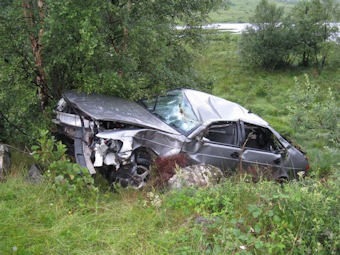
Ranald's car |
The A830 Arisaig to Loch Nan Uamh Road Improvement wins prestigious Saltire Society Award
The A830 Arisaig to Loch Nan Uamh Road Improvement, the last section of the ‘Road to the Isles’ has won the prestigious Saltire Society Award for Civil Engineering design in the Environment Category.
The A830 Arisaig to Loch nan Uamh Improvement, which was opened in April last year, was managed by The Highland Council’s Project Design Unit in Alness on behalf of Transport Scotland and was built by Morrison Construction.
The success was announced on 28th October at an award ceremony in Glasgow, which is organised by the Saltire Society and the Institution of Civil Engineers and recognises outstanding engineering projects in Scotland completed in the last two years.
Fifteen projects across Scotland hoped to win the coveted award or be recognised with a Commendation.
Councillor John Laing, Chairman of The Highland Council’s Transport Environment and Community Services Committee, said: ‘I am delighted at this good news and this reflects the exceptionally hard work put into the project by the Council’s Project Design Unit based in Alness as well as the efforts of the Contractor, Morrison Construction.
‘A major effort was made on this scheme to mitigate the highly sensitive environment which this road passes through including the Special area of Conservation and the National Scenic Area and this is reflected in the high quality design which blends into the surrounding landscape. Close working with Transport Scotland has helped achieve this significant award and visitors and travellers alike to the Road to the Isles will appreciate the scenic quality of the new road.’
Council Leader Michael Foxley added: ‘I am delighted with this award, which reflects great work by our engineers. The local community representatives, community councils, former Councillor Charlie King and I had a great working relationship with the engineers to get this superb road built.’

L to r: Stewart Higgans, Morrison Construction; Sam MacNaughton, The Highland Council;
Jimmy Smith, The Highland Council, Heather Reid, Presenter and Andrew Fowler Grontmij, Contractor’s Designer
Crofting roundup by Joyce Wilkinson, SCFA Representative/Area Assessor
Leaked Document on Common Agricultural Policy
Debate on the CAP has been stimulated recently by a 'leaked' document that outlines the 3 options for change in the CAP reform for 2013 to 2020.
There may be some measures within CAP that will benefit Small producers and crofters, but the shifting of the funding source for the Less favoured area support scheme, which is a scheme paid to hill farmers and crofters and farmers in designated 'less favoured' areas is cause for concern. The document states that this scheme which is paid to all active crofters, even although in some cases it is only a small amount, would be replaced instead by direct payments for living in areas with 'specific natural constraints' from 'Pillar 1' funding, which is the funding pot of money set aside to pay the Single farm payments .It would make Lfass less certain and secure as a payment, and the knock on effect would be an even further decrease in sheep and cattle numbers from the Highlands. To be certain and secure hill farmers and crofters need Lfass to be a stand alone payment, separate from 'Pillar 1' [money paid for agri environment schemes and rural development] and Pillar 2 [The single farm payment], which is the direct payment paid as a form of support to farmers.
One of the options debated on is to abolish all support apart from those geared to environment and climate change, this would almost certainly lead to loss of production and land abandonment
A full and thorough report on The future of Agriculture in Scotland by Brian Pack will be released on 3rd of November and discussed in full with farmers at the NFU AGM on the 17th Nov in Perth.
A series of meetings by the NFU to discuss the future of LFass following the Brian Pack report and pre leaked Lfass news will be held soon. The nearest one to here is in the Corran Halls Oban 26th Nov 7.30
An interesting document that confirms a lot of what is often talked about but isn't clearly understood can be found in http://eutransparency.org/wp-uploads/2010/10/who-runs-the-cap.pdf
Sustainable Farming and Crofting
There is a Sustainable Livestock Bill progressing through Westminster - it has its 2nd reading on the 12th of Nov. This is an important Bill to support and the jist of it is that its 'A Bill to require the Secretary of State to improve the sustainability of the production, processing, marketing, manufacturing, distribution and consumption of products derived to any substantial extent from livestock; and for connected purposes.' In short, it calls on the UK government to control factory farming of meat and milk that is dependant on imported soya that is grown on deforested land in amazonian regions.
You don't have to travel far to buy factory farmed meat from the EU ,and it is a scandal that in this country which had a natural healthy environment for rearing pigs sheep cattle and hens, that consumers are tricked and sometimes financially forced into buying meat from animals that have lived and been killed in inhumane conditions. To lend support to the bill visit http://www.robertflello.com/#/sustainable-livestock-bill/4542178368 and sign the petition. To support local and fair prices for local producers visit Lochaber Farm Shop and buy from your local butchers and farmers markets.
A further blow to Local food production came last week when the slaughterhouse at Mull burnt down. It is sincerely hoped that it can be rebuilt and the people who work these can stay in a job. The service there is second to none when it comes to the welfare of the animals .
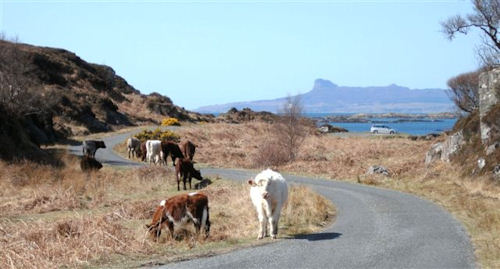
Beef bred and reared in Arisaig can be purchased locally from Lochaber Farm shop at Torlundy
NEWS FROM THE HARBOUR
This is the first of what we hope will become a regular feature in West Word - Mallaig Harbour News.
Linkspan Closure
The linkspan at Mallaig will be closed for 7 days to enable Napier Engineers to replace ropes and cylinders.
The linkspan, owned by Caledonian Maritime Assets Ltd, is set to be handed over to Napiers after the last sailing on Saturday 6th November. There will therefore be no vehicular ferry to or from Armadale from 7th November until the linkspan refurbishemtn is complete - one week later!
Navigational Aids
Eagle eyed boat trip enthusiasts will possibly have noticed that the Mallaig Lighthouse on Sgeir Dhearg (Red Rocks) and the concrete perch on Bogha Don in Loch Nevis have been painted. Harbour employees also fitted a radar reflector to the perch at Sgeirean Glasa, Loch Nevis.
Repairs
Repair work to one of the cone fenders on the roundhead at the Steamer Pier and to five of the rubber 'D' fender on the Outer Breakwater has been commissioned and will be carried out sometime over the winter.
Whale
Local adventurer Tom (Moby) McClean has approached the Harbour Authority about the possibility of placing his 60 tonne metallic whale on the site which used to house the sorely missed Mallaig Marine World.
It would certainly be an eye catching attraction at this location - just outside the Railway Station and at the A830 roundabout - but it's too early to say if the idea will come to fruition. A decision has yet to be made with all the pro's and con's to be evaluated by both parties but the Authority Members are supportive.
Extra sailings
The 2010/2011 winter service between Mallaig and Armadale on Skye is to be augmented by two extra ferry crossings.
On Friday evenings, there will be an extra crossing departing Mallaig at 1800 hrs, then departing Armadale at 18.45hrs.
On Sundays, there is to be one crossing to Skye, dep. Mallaig @1600 hrs, then departing Armadale @ 1715 hrs.
Landings
The landing stats for September 2010 indicate that only 30 active fishing boats made use of the port's facilities, and consequently landings of both shellfish and demersal/white fish show a decline in the same month, one year ago.
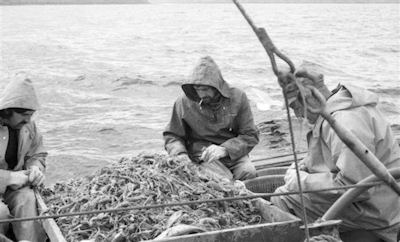
Above is a photo from 1981 when, as can be seen from the large pile of prawns on the deck of the local trawler Maggie McLean, catches were good.
Petie McLean (Jnr), Tommy Mathieson and George Alick Coull are tailing the prawns.
The photograph is from a reel of film found by Mr Phil McQuillan - see below.
Robert MacMillan, Port Manager/Secretary, Mallaig Harbour Authority
Last month, West Word received communication from Mr Phil McQuillan, Sydney, Australia, and along with his email there were 32 black and white photographs taken aboard a Mallaig trawler back in 1981.
'I've just found this roll of 35mm b & w film from 1981,' writes Phil, 'it's one of your local crews out at work on their boat. Given the time lapse, I can't remember the name of the boat or any of the crew - I'd be interested to know who was who.'
Well, we can tell Phil and West Word readers that the local boat is the Maggie McLean OB174, skippered by Petie MacLean with crew members Petie McLean Jnr, George Alick Coull and Tommy Mathieson. Tommy wasn't a regular crew member of the Maggie and must have been filling in for regular long term crew member Billy McLean. Pictured below is George Alick with an impressive conger eel!
Phil McQuillan requested that the photos be passed on to the Mallaig Heritage Centre, and we are happy to do so, with a thank you to Phil for his present from the Antipodes.
JOBS BOOST FOR THE AREA
Marine Harvest (Scotland) Ltd has provided a local jobs boost by recruiting a further eleven full time employees for their salmon harvest station at Mallaig.
'With the Mallaig Factory operating on a six day shift basis, handling high volumes of farmed salmon, the company recognised the need to increase staff numbers,' said Harvest Station Manager John Gillies. 'Consequently eleven new full time employees have been recruited in the last month, ten of whom are from the local area, with one from Fort William.'
One of the biggest employers in the area, Marine Harvest currently employs twenty-four full time staff in Mallaig.
The news comes as Arisaig & District Community Council learned of a proposed major development at Lochailort. Marine Harvest officials were guests at their meeting on 29th October and explained their plans to expand the fish farming in Lochailort, using freshwater for production of juvenile fish which would then be transferred to an off-shore farm in the Outer Hebrides. This is only in the consultation stage but if successful will provide a further six jobs, which will require technology skills.
On and Off the Rails
Jacobite Steam Train season over for another year
As I sit here writing my column for November's West Word, I cannot believe that yet another Jacobite Steam Train season has finally come to an end. Friday October 29th saw the very last Jacobite into Mallaig for 2010. Having started on Monday May 17th, it has visited Mallaig this year some 138 times!, covered some 11,592 miles, burnt approximately 1,104 tons of coal, converted 1,104,000 gallons of water into steam, and conveyed more than 44,160 passengers between Fort William and Mallaig!
It is recognised as the most popular main line steam train journey in Great Britain, the line itself having been awarded many accolades in 2010. The 'Harry Potter' connection has helped top popularise the line, and although all 'Potter' filming here was completed this year, the final book will be premiered in two films - one this November and one during next year's Jacobite season - ensuring that the 'magic' of travelling in Harry Potter's footsteps along the line still encourages Potter fans to come and visit the area.
Our thanks must go to David Smith and his dedicated, loyal team at West Coast Railway Company in Carnforth, Lancashire, for bringing the Jacobite to us. Thanks also to Ian Riley and Bert Hitchings, who both provided the Black 5 locomotives for hauling the train. Further thanks go to John Hunt of NELPLG for the use of K162005, and John Cameron for stepping in with his K4 The Great Marquess at very short notice when, unfortunately John's K1 had to return south prematurely due to mechanical problems.
The organisation and logistics of running a daily steam service on the Fort William/Mallaig line is by no means easy. A lot of hard work and planning is involved. The crew that you get to see on the train every day is just the 'tip of the iceberg'. There are dozens of support workers maintaining, cleaning and organising each day's runs.
We all look forward to seeing the Jacobite back in 2011.
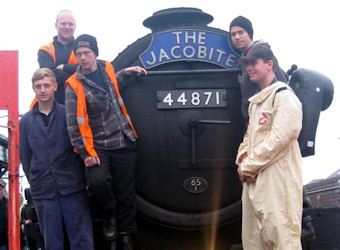
Jacobite train of 2010. Ian Riley's boys seem to have recruited a ghost buster! Photo Steve Roberts
Engines and Rolling Stock go home to Carnforth
Saturday October 30th saw two Black 5's and nine carriages leave Fort William yard for the last time in 2010. A prompt start at 08.35 was arranged in order to cross with the overnight Caledonian Sleeper Train at Tulloch. With 45407 leading 44871 (both Ian Riley's) and seven Mark 1 carriages and two 'support' carriages in tow, the train made a spectacular sight as it departed Fort William.
After crossing with the Caledonian sleeper hauled by Class 67 Diesel No. 67011 with four coaches, the two locomotives made light work of their 500 ton train as they climbed up into Corrour, passing Loch Treig. With Driver Peter Walker on the front engine, and Alex Iain MacDonald driving the second engine, the train made good time to Bridge of Orchy, where a booked crossing with the ex 08.21 Glasgow Queen Street to Fort William/Mallaig was arranged. The Jacobite arrived first so there was time to enjoy a wonderful cooked breakfast of bacon, lorne sausage, eggs, etc, all cooked up by regular Jacobite Guard, Florence MacLean, ably assisted by Ian Riley's 'boys' and John Rogers, a West Coast Fireman from Machynlleth in Wales! As the Northbound 156 Sprinter approached Bridge of Orchy, it was time for West Coast to put in place a crew change. Alex Ian was replaced by regular Jacobite Driver Paul Kane from Carlisle, and Florence MacLean handed over Guard duties to John Rogers. The train then departed and headed for Crianlarich via the famous 'horseshoe curve' and Upper Tyndrum. En route, hundreds of photographers were following in cars and 'foot soldiers' lined the hills, all wanting to take in the very rare experience of witnessing two powerful locomotives making very light work of their heavy train. On arrival in Crianlarich, it was decided to make a short stop for photographers to take pictures and to move forward several tons of coal on both tenders. Ian Riley and Peter Walker felt that enough water was in store on both locomotive tenders, so the water hoses were deployed by landrover to Craigendoran in order to meet the train and refresh both water tenders there. At Garelochhead the train passed yet another Class 156 Sprinter, northbound, and after a brief stop headed south for its run along the Clyde and onwards, finally, to the West Coast mainline, and past Glasgow onwards to Carlisle, where another crew change was planned. The final leg then was down the West Coast mainline and into Carnforth.
Meet the Managers day in Mallaig
Wednesday October 20th saw a 'Meet the ScotRail Managers' open meeting at Mallaig Railway Station. It was to have been held in the Booking Office Concourse, but the day was so beautiful it was held outside, alongside the still flowering hanging baskets! Three Managers were present, namely Angus Tough (ScotRail Head of Stations), Tom Daly (ScotRail Head of Train Care) and Alasdair McNicol (ScotRail's Project Director). Local businesses, community volunteers and general members of the public attended, as well as representatives of the Community Council, Harbour Authority and West Word. It was a chance for all to meet individually and collectively with the Managers and discuss rail related issues and matters arising from them. The session was held between 1.30 and 3pm. Questions were certainly asked and answers were sought. Notes and photographs were taken in plenty. At some time in the near future, a report of the day will be published by ScotRail and John Yellowlees (ScotRail's External Relations Manager) has assured me that a copy of it will be sent to me, hopefully in time to publish in December's 'On and Off the Rails' West Word column. Watch this space!
Friends of the West Highland Lines - West Highland News 'Plus' Autumn/Winter Magazine - out now
The latest issue of the well informed, excellent value for money (£2.25) magazine is now out. The colour front cover shows a stunning photograph of Ian Riley's Black 5 standing at Oban, whilst taking a short break from its usual duties. It has been taken by our very own Moe Mathieson. Well done Moe!!
Moe also has another photo published on page 15. it is a rare shot of Black 5 No. 45407 and K4 61994, The Great Marquess. This particular photo was taken in almost total darkness, at 8.45pm, although due to Moe's great photographic skills it appears to be much earlier in the day than that!!
Copies of the A4 size magazine can be purchased from me, just give me a call on 01687 462189 and I will arrange prompt delivery. Alternatively it can be obtained at 'Bill's Place', newsagents at Fort William Railway Station Concourse. Should any of you wish to join this excellent organisation (which means that you automatically receive 3 copies of the magazine in the post each year), I have membership forms available for you to fill in and return to the membership secretary. The cost per year is £12 for an individual membership, £18 for a household, or £15 for a Business Associate Affiliation membership. By the way, their in-house advertising costs are very realistic and competitive. As members are all over Britain, why not advertise your business (mail order), Hotel, B & B, Guest House, Café, Restaurant, Shop, etc. in the 'Friends' magazine.' It could benefit your business whilst helping a very worthy and enthusiastic society.
Club 55 - ScotRail £18 offer still on!
This excellent offer for reduced price return rail travel is on until November 30th for outward travel, with one month to return after that. Easily understandable leaflets are available from staffed Booking Office stations and should be used if you are 55 years of age or over.
In Scotland any service, drawing an imaginary line from Berwick-on-Tweed to Carlisle, is included (excluding the Caledonian Sleeper!) but I understand that other 'first group' railway companies are also running a 'same time' scheme, so you can 'add on' if you wish to travel further south. Try it!!
See you on the train.
Sonia Cameron
Alex MacDonald, one of the drivers of The Jacobite remembers as a young boy in Mallaig Depot cleaning and polishing the K2 steam engine pictured in the September issue of West Word and getting the odd 'firing' turn!
Alex and his wife Barbara have sent us three more steam train photographs:
Right: Driver Alex MacDonald and fireman Scott Gillies with two support crew in Black 5 Loco before privatisation in 1995
|
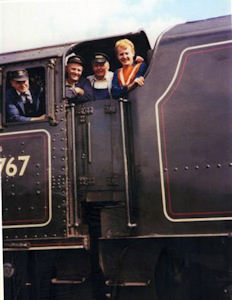 |
Above left: Special double headed steam train trip commemorating the Centenary of the West Highland Line (Glasgow to Fort William) in 1994 at Kinloid, approaching Arisaig on the way back to Fort William. Drivers Calum MacRaild and Alex MacDonald K4 leading and K1
Above right: Same commemorative special at Loch Eilt between Lochailort and Glenfinnan.
HELP EDDIE SAVE THE BLUEBELL
Eddie Scott from Eigg is helping to save one of Scotland's most threatened and iconic wild flowers. The delicate native bluebells which carpet woods in colour are under severe threat from cross breeding with imported Spanish bluebells.
Eigg is a stronghold of the Scottish bluebell, which transform swathes of the island into a sea of deep, rich blue each spring.
Now Irishman Eddie Scott, who lives in the crofting township of Cleadale, is harvesting wild seeds to help secure the native bluebell's future on the mainland.
'The bluebells on Eigg have never been exposed to the Spanish variety so have not cross bred to become hybrids,' he explained. 'In a lot of places the hybrids and Spanish bluebells have driven the native ones to the brink of extinction. Planting more pure Scottish bluebells will help strengthen their foothold once again.'
Turning a hand to a host of activities is part and parcel of life on an island. Eddie is a legendary spoons player who regularly plays with Scotland's top musicians, and teaches spoons at the world famous Celtic Connections festival. He's also a skilled bodhran player, gardener, fruit grower and salmon fisherman.
His gardening skills are being put to good use on the island. Eddie grows fruit and vegetables in a polytunnel on the croft, supplying surplus produce to the shop and tea room, and is a volunteer on a range of community projects, such as helping to establishing an orchard on the island.
The plan to diversify into seed gathering came when Eddie realised his croft was a sanctuary for the threatened wild flowers. 'I was trying to think what I could produce on the croft that would be light and easy to export off the island. My idea was to grow plants for making herbal teas; but when spring came I realised the croft was awash with bluebells, which I knew were becoming rare in many places.'
Staff from the Botanic Gardens in Edinburgh verified the purity of the seeds verified, and Eddie obtained a licence from the Scottish Government to harvest a strictly limited number of them from the croft each year.
Artist Saira Renny and graphic designer Ben Cormack are among the growing number of young people who have moved to Eigg or returned to make the island their home. They worked with Eddie to create distinctive packaging for the seeds, which are sold in the island craft shop and online.
Seeds can be sown from September to March and take two to four years to mature. For more information and to buy them online go to www.eddieseiggcroft.com
News in Brief
- Pope Benedict XVI has praised the group of Lochaber companies who presented him with a hamper of Highland produce on his visit to Scotland last September. Among them was Mallaig's George Lawrie & Sons Ltd.
- Following a successful pilot scheme in the west of Scotland the Emergency Medical Retrieval Service, Scotland's flying doctor service, is being rolled out to remote and rural parts of the country from 25th October.
The service, staffed by air paramedics and consultants who are specialists in emergency medicine, will fly across Scotland to treat critically-ill patients on the spot. Since it began in June 2008, the team has undertaken 565 retrievals and given advice to a further 469 patients.
- SNP's Dave Thompson MSP was extremely embarrassed last month when election leaflets was printed showing the Isles of Eigg and Rum had swapped places. The P & J couldn't resist saying he had 'Eigg on his face' and that it was 'a Rum do'.
- BT's Race To Infinity (...and beyond?): BT has started rolling out 40MB Broadband by upgrading to fast fibreoptic cables. In the Highlands & Islands, many of us are on exchanges with less than 1000 lines, which will not be upgraded unless 75% of those connected sign up. Faster broadband is going to be a key part of keeping our communities viable - so start today and encourage your friends, family, neighbours and audiences to sign up on the Race to Infinity website.
ARISAIG HOUSE - A NEW CHAPTER
In May 2010, Arisaig House was sold by Ruth Smither to Emma Weir, and a new era began in the life of the house.
We said a fond farewell to Ruth and her son Andrew, who had made the difficult decision to move away from Arisaig back to their roots in the South of England after 29 years here; and welcomed Emma and her sister Sarah and husband Peter Winnington Ingram and their family of four to the village. Arisaig House was about to become a luxury Guest House.
Emma is a business woman who has based her own head hunting company in Arisaig House and is here as often as time allows, full of ideas and enthusiasm for her new undertaking. Sarah has spent all her adult life in the hospitality industry, working as a chef in restaurants in London and Edinburgh. Before moving to Arisaig, she was the General Manager of Harburn House just outside Edinburgh, an exclusive use venue for conferences and weddings.
Sarah and Peter will be managing Arisaig House as a family run Guest House, and will continue to let out the six self-catering cottages. The existing staff have all been kept on and Sarah hopes to recruit any extra staff locally. They would like to correct the story in the Saturday Times that Sarah owns the house and is planning to turn it into a luxury hotel! 'The emphasis is on a family run guest house, open for dinner, bed and breakfast,' Sarah told West Word.
Sarah says 'Food is my passion - where it comes from and its production. My hobbies include foraging, collecting wild mushrooms, that sort of thing. We will be sourcing all the food used in the House locally as much as possible.'
Emma and Sarah have big plans for the garden. A 48 ft polytunnel has just been acquired for the walled garden and by April next year they hope that they will be sourcing all their fruit and vegetables from the garden, with any surplus being sold locally.
Future plans for the House, which will be open all year round, include running events and hosting weddings and special occasions, majoring on providing top quality dinner, bed and breakfast, with dinners available to non residents by arrangement. Residential art courses are already planned for April and September of next year. Emma and Sarah are also keen to highlight the history of the House, including the connection with the SOE in World War II, and to make it more accessible to interested people.
There are eight high quality en-suite guest rooms in the House, and six self catering cottages in the grounds. There are thoughts to completely overhaul the heating system, moving from oil to a biomass boiler, with wood burning stoves situated throughout the house.
Why Arisaig? Emma and Sarah reckon they have probably spent more time in this part of the world than anywhere else. There is a family connection with Kinlochmoidart, where they spent all their school and working holidays, having a cottage there since 1966. Sarah and Peter were married there in St Finan's Church 21 years ago - they actually spent their wedding night in Arisaig House! - and it is where Emma and Sarah's parents are buried. The urge to move here has always been strong. Sarah says that everything she has done up to now feels as if it has been in preparation for this.
Birdwatch by Stephen MacDonald
A few more birds arriving this month, with Redwings and Fieldfares appearing by the end of the first week. A nice surprise was the arrival of Waxwings in the area on the 24th. Good numbers were seen in Mallaig, Morar and Arisaig over the next few days, but numbers declined rapidly as they moved on. However, there are still plenty of berries around and Waxwings are still coming into the country so keep a look out.
Still a few geese passing over with flocks of Pink-footed Geese seen on several occasions. There was a single Pink-footed on the Morar Estuary at Bourblach on the 4th. on the 11th 4 Goldeneyes on the West end of Loch Morar were the first reports. Whooper Swans were first seen flying over on the 14th and on the 19th two adults on Loch nan Eala, Arisaig, were the first reports from there. At the end of the month there were 2 adults and 1 juvenile feeding there.
Twenty Golden Plovers were seen at Traigh on the 5th and 4 Redshank and 2 Greenshank were at silver Sands the same day. At least 3 Greenshanks were seen on several occasions on the Morar Estuary throughout the month. Small numbers of Dunlin and Turnstone were seen at Traigh during the month.
Three Common Crossbills were seen at Rhubana View for several days from the 5th feeding on Norway Spruce cones. Flocks of Siskins and Redpolls were reported from Morar and Arisaig and Goldfinches were reported from many gardens during the month. Several Reed Buntings were at Rhubana at the month end.
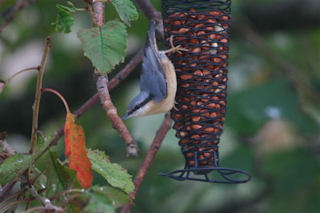
Nuthach |
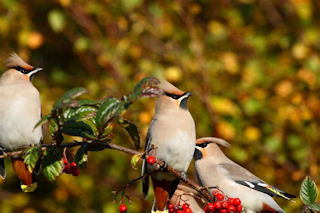
Waxings - photos by by Stephen MacDonald |
The Nuthatch was still coming to feeders in Arisaig throughout the month.
Numbers of Great Northern Divers built up at Traigh during the month and several Red-throated Divers were also present. Red-breasted Merganser numbers also increased on Loch nan Ceall and the Morar Estuary.
In the windy weather, Gannets could still be seen close inshore and there were several sightings of Great Skuas in the Sound of Sleat during the month.
A few more Manx Shearwaters were rescued during the first half of the month bringing the number this year to approximately 155 birds that were rescued and then released. At least 5 of the birds picked up in Mallaig had already been ringed on Rum prior to fledging. A big thanks to all those who reported or handed in grounded birds.
Four Swallows lingering at Rhubana on the 16th were the latest reported.
A number of ‘By the wind Sailors’ were spotted on Traigh beach by Stephen MacDonald
on 30th/31st October. They are a warm water jellyfish (which don’t sting)
usually found further south off Devon & Cornwall.
They are very small - about twice the length of a 50 pence piece.
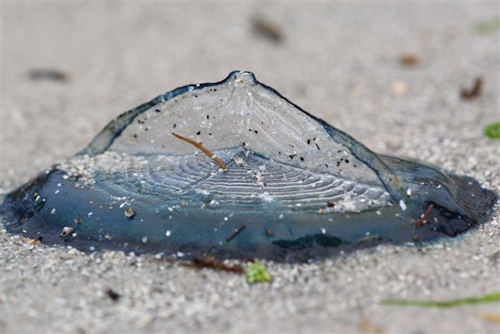
|
WORLD WIDE WEST WORLD
Mallaig's Steven MacDonald and Tom Baillie took their copy to the summit of Ben Nevis on 10/10/10! They say thank you to Duncan MacDonald, Kevin Halsall, Hector MacLellan and Ross Milligan who went with them and to everyone who sponsored them, the funds raised are going towards the London trip with Mallaig High School next year.
|
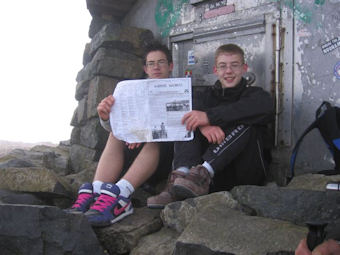 |
Frank was pictured selling West Word in Torquay by Robert and Ann MacMillan!
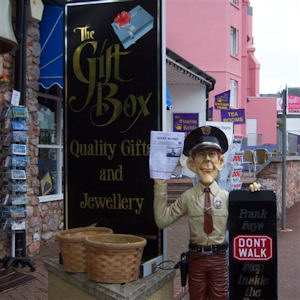 |
Angela O'Donnell (below left) told us 'The new colour edition of the west word has gone to Hollywood!!!' Angela, from Mallaig, now lives in Texas and gets her monthly West Word courtesy of her mum, Mary.
Below right Helen MacNicol (nee Anderson) is enjoying browsing through the West Word which her pal Alison McLean sends from Mallaig every month. Helen and hubby Fraser were on holiday in Bavaria and sampled (?) the Munich Oktoberfest. This pic was taken on a visit to Neuschwanstein Castle.
|
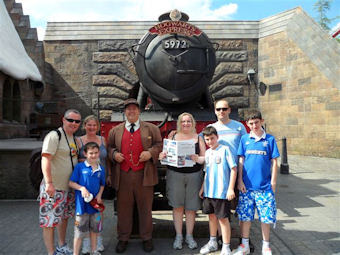 |
Lindsay Jones (Arisaig) took her copy to read next to the Hogwart's Express at The Wizarding World of Harry Potter, Universal Studios, Orlando Florida. She says 'The Harry Potter World is great and features Loch Shiel and the Glenfinnan viaduct.' In the photo is Lindsay (daughter of Hugh and Muriel MacDougall, Arisaig), holding th West Word, with her husband Michael on her left, and with them and the Lamont Family. Shona Lamont is the daughter of Finlay Dempster, Arisaig!
|
A TALE of two dogs
On Tuesday 5th October Gemma van der Zanden took her 15 year old dog Jake for a walk, and decided that, instead of going up the hill at the back of her house in Morar as usual, she would park her car at Glasnacardoch and walk up towards Loch an Nostarie.
Up on the hill Gemma and Jake became separated and Gemma eventually had to go home without him. She went back the next day to search but there was no sign of him and, realising he was in an unfamiliar area, a distressed Gemma thought he was gone for good.
Four days later, on Saturday 9th October, out walking in the hill with his own dog, 13 year old Jock, was Angus MacLellan, son of Ronnie and Mary, Seaview, Morar, home for a week from his job in Lagos. A keen photographer, he was hoping to get some good shots of rutting deer, and walked far up into the hills to get close to a number of them.
He saw a black dot in the distance which puzzled him, and through his telephoto lens he identified a dog wearing a collar. Thinking the dog may belong to someone in difficulty, it was important to retrieve the dog or at least, check for contact information/identification on the collar.
He managed after some time to get close to Jake - for that of course is who it was - and began to bring him back down with him, but the dog was exhausted and couldn't travel very fast. Angus had to carry him over parts of the hill, and to coax him through a fence and then over a stream, which panicked the old dog who seemed to be afraid of the water. He rushed off in the wrong direction and Angus lost valuable daylight trying to regain his trust. It all took so long that darkness had fallen long before they were down safely.
Angus takes up the tale: 'Gradually we settled into a rhythm, Jock scouting ahead following scent on the path and Jake, gaining in confidence feeding on the remnants of a cereal bar, bringing up the rear. All was well as a cluster of trees broke the skyline to the left, close to a stream where Jock had drifted from the path. Calling him back, he immediately barked and yelped amid sound of commotion but did not reappear. I rushed down to the trees to find him, but it was clear the situation was not good for Jock. Two deep-cutting streams converging to a point near a waterfall. In the dark it seemed a long way down and with a growing sense of horror it was apparent Jock was down there and not responding.
'Jake emerged from the darkness with his now characteristic slow loping gate. So as not to make a bad situation worse (and not knowing his name) I lunged to grab him and prevent him falling over an edge. Still wary, he shied away to escape and in doing so fell through a gap in the undergrowth and into the darkness. As he crashed deep through the stream-cut towards the base of the waterfall, I could follow his decent but the exhausted Jake made no sound.
'This was becoming surreal. Two dogs had just disappeared. All was quiet other than the relentless flow over the waterfall. I laid down my camera gear and produced a torch to investigate. Suddenly I too was falling, the stream cut was over-grown and I'd stepped out into the gap. This was going to hurt! Fortunately, a rock ledge broke my fall and I tumbled, coming to rest sooner than expected on another ledge in a narrow ravine with more darkness to my right. It was a little like playing hide and seek and finding yourself in a haunted wardrobe, not knowing quite what to expect at the bottom. With my right foot twisted clockwise through 90º, my leg was stiff and probably broken. Clearly this was a problem and something had to be done. Getting up would be doing something, therefore should be done!
'Suddenly, falling rocks crashed down the trench to my left and I braced. It was Jock, crawling down the stream bed his face twisted and fearful, he pushed into me and his body went limp. I grasped his collar and wasn't going to let go. We were both very close to the edge.
'Although immensely relieved to see Jock, he seemed to be in a bad way. Jake had continued over the next ledge and was either suffering badly or had gone. Shining a light over the edge revealed nothing but the leaves rustling in the breeze. It was time to go. Jock could barely stand as I braced myself against the wall of the stream so lifted him up to a ledge and climbed up after him, displeased at using my knee in the climb, although unable to gain a foot hold under the circumstances.
'Reaching the top of the climb, Jock was back on his feet so I crawled briefly until picking up a mobile reception and phoned home. Pulling Jock in close to keep warm, I settled for the night thinking of Jake in the gully below.'
By luck, Donald MacLellan, a family relative, was visiting Mary and Ronnie when the phone call came. He knows the hill well and had actually flown over the area some days earlier with Hamish Smith in his microlight, so he was able to form a mental picture of where Angus was.
The Police were alerted and Donald was able to pinpoint the location on a map following the description from Angus. At his suggestion, Ian Macnaughton, with his Coastguard experience of search and rescue, was called out.
Without hesitation, Ian and Gavin Johnston went out on the quad bike and were able to locate Angus, two and a half hours after he had fallen. The weather was fine but there was no moon. The Rescue helicopter arrived and, following an assessment of difficult flying conditions the pilot was able to touch down part landing - part hover and hold position. The on-board medic quickly grasped the situation, applied an inflatable splint to Angus' leg and he was strapped into a stretcher and flown to Broadford Hospital. His dog Jock was also rescued but poor Jake was still lost in the depths of the hillside.
Next day, Ian and Gavin went back up to the hill, concerned that there may have been a person with the old dog who could be lying injured somewhere. Donald had the same thought. Finding no trace of anyone, the three tried to find the dog. Although they located the ravine easily, it took them a while to finally find old Jake, cowering on a rock ledge about eight feet down, a waterfall to one side and a pool to the other - afraid of water! The poor old fellow looked as if he had given up. They went down to him, got him into a Coastguard bag designed for such rescues, and hauled him out by a rope attached to the quad bike.
Now, at this point, no-one knew who the dog was or who he belonged to - so poor Jake's adventure was far from over. He was taken to Mallaig Police Station, and from there transferred at Lochailort to Donna of the RSPCA, who took him to Fort William. There he would have stayed a week until fostered out.
But never underestimate the bush telegraph! Mary told her sister-in-law Molly Buchanan about the incident, and Molly instantly put two and two together, having heard the story of the missing dog from Gemma, and identified Gemma as the owner. So after five days, Jake and Gemma were reunited.
After rest and good feeds, Jake was none the worse for wear - Angus had come off less favourably, as he has been unable to go back to Lagos when planned and will remain on crutches for two months. After being taken to Broadford, he transferred to Edinburgh Royal Infirmary for an operation. His leg is mending well and he hopes to return to Nigeria in January.
A sad end to the tale - as West Word is going to press we have learnt that Jake has died, after a few days of being unwell..
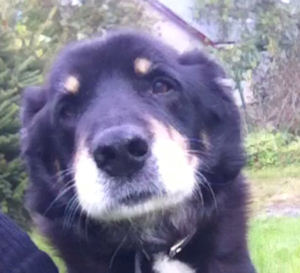
The Isle of Rum, 10.10.2010: the day of the Asiatic sprite
Mike Werndly IRCT Ranger Service
Due to the efforts of the SNH Reserve Team, Andrew Ramsay (Highland Ringing Group) and various visiting colleges and university groups, much is known about the breeding birds which are usually encountered on the Isle of Rum. However, not all is known about the island's avian visitors which are using the island as a stopover after being blown thousands of kilometres off course. Being one of the last pieces of rock between here and Newfoundland, there's always the chance of a windblown vagrant or scarce migrant turning up, and Rum definitely has the ability to surprise the visiting birder.The island could potentially rival the Western Isles (a very fine birding destination) if there was more observer coverage. It had its fair share in the past, which resulted in some interesting records.
Looking back into Rum's ornithological history during the summer, I consulted the SNH library at the Reserve Office and quickly came across a heavy blue leather-bound volume entitled Isle of Rhum-Birds. This was largely compiled from 1957 by Rum's legendary first Warden, Peter Wormell, and the Bible of Rum ornithological records. This was the first work of its kind conducted on the island and its thoroughness not equalled since. Not just the birds were recorded; it is a full inventory of all island species from higher to lower plant communities to dragonflies and moths. With the assistance of Mr. N. G. Campbell, Dr. W.R.P. Bourne, Mr. C. Booth and Dr. W. J. Eggeling, Peter Wormell recorded everything that swam, flew, grew or squirmed in the acidic soil, now forever immortalised in the volume's musty yellow pages. Rum was then the outdoor laboratory and forbidden, closed to the majority of the general public. Nothing peculiar was going on out of public view however, the forerunner of SNH, the NCC (Nature Conservancy Council), just wanted time to conduct pure science and to record the islands biology on behalf of the nation. Information that was hard won and which we still appreciate today.
Thanks to these early studies, I learnt that Rum has had its fair share of nationally scarce species in the past, and a quick flick through Wormell's bird volume exposes some remarkable finds, i.e., a little bunting in 1957, a king eider in 1966, a lesser grey shrike and rose coloured starling both in 1971, and a red-headed bunting in 1972.This was an impressive list. Even in more recent years there's been some interesting finds , with a single buff breasted sandpiper in 1995 (a North American species), another rose coloured starling in 2003, a hoopoe from southern Europe in 2006 and a red-backed shrike in 2009. .No wonder the young George Waterston, the founding father of Fair Isle Bird Observatory and co-founder of the Scottish Ornithologists' Club had conducted preliminary migratory bird studies here in 1934. A year later in 1935 he found what he was looking for, Fair Isle in Shetland, undoubtedly the Mecca of British birding, but the Second World War halted his immediate plans. Whilst waiting out his time in a P.O.W camp in Nazi Germany, I often wonder if Waterston did consider setting up a bird observatory here on Rum, or whether purchasing Fair Isle for such a purpose was unmoving in his mind. He must have paid Rum some thought as he may have been aware of Lady Monica Bullough's intension to sell the island, plus Fair Isle wasn't on the open market at that time (he bought the island in 1947). Maybe Rum's £23,000 price tag put him off, or was it the midges?
It's amazing how some of these vagrant species make it to Western Scotland in the first place, as most breed thousands of kilometres away from our island's shore. Take the little bunting, which breed no nearer than arctic Finland and was recorded over at the Harris shepherd's bothy back in 1957.This species tip the scales at just a few grams and measure less than 13cm from tip to tail. Given the size, you would be hard pressed to imagine this species making any journey more risky than a hop from bush to bush in search of food, let alone making it to Rum alive. So why do they come I hear you ask? Well, it's certainly not for a castle tour; it's all down to meteorological factors you see. Many Scandinavian migrants will depart in a south or westerly direction to their wintering quarters usually during anticyclonic conditions with light winds and clear skies. However, if they encounter adverse weather during their flight, i.e., a big bad depression crossing the North Sea, they may be wind drifted westwards to Scotland. Most Scandinavian migrants land on the east coast, but as Scotland isn't that big at the top (being English, dare I say it), birds can quickly filter from east to west with commoner species in no time at all, or they can completely overshoot the country. And once here on the outer islands, they have nowhere else westward to go, except for a one way suicide mission across the North Atlantic.
So what other birdy (some say nerdy) secrets does the island hold for the visiting birder, the island hasn't moved anywhere, it's still ideally positioned on the edge of the Scottish mainland and ready to receive? Last weekend (9-11th Oct) we found out with two 'firsts' for the island, two species that had never been recorded on Rum before. Oct 2nd heralded the start of what was to come a week later when Rum' s first pied flycatcher since 1972 turned up at the Kilmory tree plot. With the continued easterly airflow dominating this part of Scotland and bringing fine settled weather, those out in the field were rewarded with birds literally dropping out of the sky. Something very special was happening, late shearwater young were thudding down in the village at night, but something less usual was occurring during the day. On Saturday 9th the winds had brought in dozens of redwings, fieldfares, blackbirds, meadow pipits, siskin, chaffinches, goldcrests together with bramblings, crossbills, blackcaps, a single spotted flycatcher and a common scoter. The warm settled conditions were also responsible for raptor activity with a lone female hen harrier and an immature golden eagle observed high over the village on several occasions.
The day had been fantastic and one of the best that I can remember. There had been plenty of birds to study during the bird ringing demonstration that had been laid on for a visiting university group. However, the fantastic day wasn't over yet, as I was in for a big shock on the last net round. As I approached the mist net, I was greeted with the usual squeaks from a party of long tailed tits which had caught themselves and were hanging helplessly in the fine mesh net. As I looked up and down trying to choose the nearest bird to extract, I soon became aware of a thrush sized bird wriggling quite rigorously in the bottom panel. As walked up to it my eyeballs nearly exploded, for in those few steps, the thrush had materialised into a *****y hawfinch (!!!), one of the most secretive of all birds and not often seen anywhere, let alone on Rum! I was obviously delighted with the find, but I soon felt the pain as I started extracting it, for its bill is designed to crush cherry stones and my thumb apparently. It was ringed, processed (and appreciated) as quickly as possible to limit stress and was released unharmed. Gone forever, but not forgotten, it was last seen flying from my left hand into the tall pines behind Kinloch Castle and has not been seen since. The hawfinch is a rare Scottish breeder of lowland deciduous woodland, but this individual was presumably an eastern European migrant that had been caught up in the same westerly movement as the commoner species.
Even with half a thumb, this chance encounter with the hawfinch had spurred me on. I was now determined to find out what else was lurking in Rum's bushes? The next day was 10th Oct 2010, and if you believe in such things, surely an omen. By chance, I had been given the opportunity to check the various tree plots which run the length of Kilmory Glen for the day, and it was here that it happened; the yellow browed-warbler, an Asiatic featherweight that breeds in the Siberian taiga and winters in SE Asia. In all probability, it had made its way from somewhere in central Asia over to Scandinavia and was now (whether it liked it or not), apart of the same westerly movement of migrants. Sorry to ham it up, but this bird was amazing. It appeared out of the leafy green shade like a little cartoon character, a bright green and yellow sprite no more than a few grams in weight. Trying to put on a little more weight after such a long journey, it darted frantically from leaf to leaf, gleaning the last of the summer's small insects with its tiny bill. As it was feeding fast in the higher canopy, there was little chance of any hand injury this time.
So our island still attracts scarce migrant birds, but the absurdity is that now the island is, and has been fully open to the general public for many years, very few birders actually take the time to visit the island during peak migration times when there's much to offer. It's definitely well worth it and it's easier (and cheaper) to get to than the Western Isles and Shetland with shorter crossing times. So why not give Rum a try next autumn? 2011 may have an American theme, with an all star line up including red-eyed vireo, ovenbird, or even a northern parula (the not so far away island of Tiree recorded one this autumn). Who knows what may turn up with more coverage!
For more information on the Isle of Rum Ranger Service please visit www.isleofrum.com or check out this autumn's copy of Scotland Outdoors magazine.
Thanks to Paul Cairney from Bannockburn for sending us this beautiful photo of the Aurora Borealis.
He says ‘I was at Guirdal Bothy on Isle of Rum and on the night of the 11th October
I witnessed and photographed an amazing display of the northern lights.’
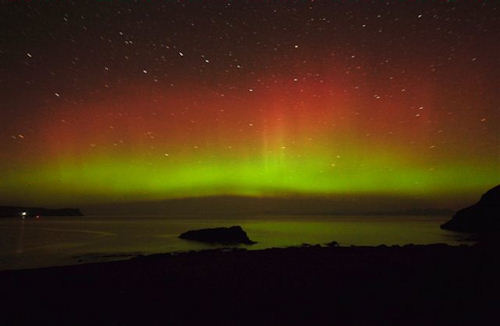
TRIPPING THE NIGHT FANTASTIC
The end of October signals the start of the best viewing period of the year - the clocks go back, which means more night! However, November is a relatively quiet month as far as what we can see.
Another meteor shower rains again around the middle of the month. The Leonids, the particles from comet Tempel-Tuttle this time, peak around the 18th. As the name suggests they radiate from Leo, most likely after midnight. They can be spotted anytime between the 13th and the 20th but remember that waxing moon, which will be full on the 21st. Look East below the Plough to find Leo.
These meteor showers, while spectacular, also serve as a timely reminder of how perpetually close to being a cosmic pinball the Earth is. During October an asteroid passed within 28000 miles of us - around a tenth of the distance to the moon. The double-decker bus sized rock would have most likely burned up in the atmosphere, however consider the outcome if it had been bigger and fractionally closer...
Comet Hartley is now retreating, but Deep Impact will be carrying out its flypast on November 4th. And while the craft will not be visible, the comet may still just be seen down in the constellation Monoceros during November. Monoceros follows Orion into the sky, rising in the East at around ten just behind the hunter.
Meanwhile, the planets give us a few teasers this month. Venus is between us and the Sun at the end of October, but within two weeks should be appearing as the morning star. Look South East if you're unlucky enough to be up before sunrise. It should be bright enough to shine on into the dawn.
Saturn also plays its morning role, rising in the East before sunrise and drifting well up in the South Eastern sky by dawn. Find the Plough, and follow the curve of its handle down and right to find the bright star Arcturus. Saturn will be about 30 degrees further right. You'll need a telescope to see any rings though.
Jupiter hasn't moved much since last month, relatively speaking. It'll be due South in the middle of the evening, and still proving to be the best planet to view this month, especially when Mars is still doing its elusive vanishing act, following the sun below the horizon each evening.
Happy viewing!
Rory Ellis
|
SPONSORED RIDE FOR WORLD HORSE WELFARE
Anna Wilson, Knoydart
What a great week that was!! Those of you who have been following my progress will know that I have been busy fundraising for a sponsored challenge to ride across the North of Scotland in aid of World Horse Welfare.
I travelled up to Brora on the 4th September, and when I reached my room at the Inn, a wee head popped out the door in the room next to mine and went 'Oh! Are you on the ride too?'' and so I meet Leanne, a great lass from Aberdeenshire. The fact that she had brought along a whole bag devoted to chocolate made me think we were definately on the same wavelength! Whilst eating dinner, discussing the adventure ahead, two heads popped around the corner, and said 'Oh! are you on the trek?'. And so we met Elaine and Fiona, and we rearranged all the tables so we could sit together. Then two more heads popped around the corner, and we rearranged the tables some more to accommodate Hayley and Jo. We all hit it off straight away, and chatted 'til late that night.
|
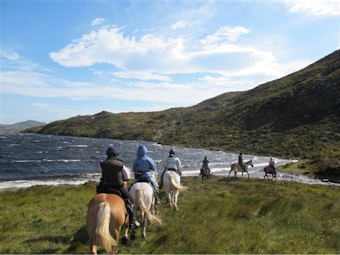 |
Anyway - the trek!
All ten challenge riders met in the morning at Highlands Unbridled, the little trekking centre ran by Jan and Graham O'Neill, that WHW had chosen to coordinate our trek and provide the ponies, food and equipment etc. In the end they provided so much more than that in the way of fantastic company, much laughter, amazing banquets from Nikky the, and a bit of ceilidh dancing too! Everything was loaded up in the Volvo and horsebox, including Leanne's luggage which was around four times the size of everyone else's and headed to Lochinver, our starting point. On arrival, it looked very like Arisaig, complete with caravan site and all the ponies were waiting at the gate. They were all shapes, sizes and colours, and I was allocated a little black one called Connie. Starting with a beach canter, and with the ponies freshened up we rode over the hill until we met some wild pigs, which despite Jan assuring us they would run away, they did the opposite, and the horses bolted down a steep rocky track. After doing a quick head count, we realised that Ruth was missing on Annie…Or rather NOT on Annie! She was fine though and we headed up and onwards to a little loch below Suilven mountain. The wind which had been a heavy breeze, was now starting to pick up, and Nikky had to cook our evening meal from inside the horsebox! By the time we all went to bed, it was getting on for gale force, and I woke up at 3am after getting hit in the head by the tent poles blowing inside out!
The next day was to be the hardest, and the wind had shown no sign of blowing itself out, in fact it got stronger! By the time we had wound our way up some old sheep tracks and over on to the tops of the hills, our ponies were blowing sideways in the gusts! It got to the stage where we simply had to get off and walk until we got back down to a less windy level, and it made me realise just how surefooted the horses have to be! After around twenty-two miles, we arrived at an old deserted farmhouse at Ledmore Junction.
Day three dawned and everyone was feeling their aches and pains, though especially Ruth after her fall. Once off, we rode up a forestry track and despite so many stops and starts from people losing jackets and easyboots mid-gallop, we managed a few canters before riding onwards through a large bog, and while we led the ponies through it, most people got left behind the horses, though at least no one sunk, as Jan recalled from passings before! Fiona was on hand with her hip flask, and we had great fun passing the parcel down the lines and back again, getting warmed through with 'House of Bruar Sloe gin', we never stopping chattering and laughing all day. I thoroughly enjoyed the banter between us all and it kept our spirits up when we were getting cold. The ponies gallantly carried us home, and we were soaked by the time we got back to camp at Oykel Bridge.
The next morning, we headed over the heather moors for Croick estate, and what started as a very dreich day turned out as bright sunshine by lunchtime. After meeting a padlocked gate, we had to cross the river and go the long route- but it was much more fun as we had the grass flats to have a collected canter on- though my steed Connie was more up for a flat out gallop to get to the front! As the day wore on, we all took turns guessing where we were headed and were assured by Jan that it was 'just around the next corner'…only by the end of the day did we realise just how many corners there were! After eight hours in the saddle, we crossed Bonar Bridge and up a short stretch to a farmhouse with spare fields for the tents and horses. We begun the now ritual-like business of untacking horses, washing them down, wrestling with the so-called "easy"boots that protected the horses hooves like shoes and turning them out, before finally sitting down to a wonderful dinner and a wee ceilidh in the hay barn!
Day five dawned bright and sunny, and we were soon on the road again- this time riding alongside Loch Migdale for some faster work before heading on the Spinningdale to Bonar road and over the hill to Loch Buidhe. We had just reached our lunch spot, when a man drove up alongside us, took a good look and carefully began unpacking some fishing gear. He had obviously planned on a quiet days fishing in the back of beyond, and didn't quite visualize being invaded by a crowd of riders and horses. We left him in peace and started riding early after lunch as. despite being warm in the morning, it got colder and wetter and we were trying to avoid the worst of it. In the end we got thoroughly soaked through, and Fiona and I felt a little stupid for not packing our waterproof trousers-surely both of us had lived in Scotland long enough to not rely on the weather! The thought of hot showers for the first time on the trek kept us going though, and we finally wandered our way into Rogart, and to 'Sleeperzzz', a few converted railway carriages. Nikki the cook had spent all day laying on a wonderful supper for us, and the drinks were flowing as we sat outside, wonderfully clean…just a shame that the midges fought us and won, and we retreated to our bunk beds at various stages, the last in the early hours of the morning.
We were all up again soon after, very excited to be on the last leg of the journey, and the horses were raring to go, champing at the bit- literally! There was a great atmosphere and the day seemed to fly by. The weather was wonderful, and though Fiona and I had both packed our leggings, we were glad to not have reason to use them! After crossing over some more bogs and heather, late lunch by a hill loch, then down across the A9, and over the railway. A calf literally just popped out when we rode past, and we paused to watch it sit up and gradually wobble to its feet. Then we hit the beach! The horses were flying along, and there was something magical about being there, galloping along a deserted sandy beach with the sun beginning to set behind us. Carrying on past the promenade at Golspie, we posed under Dunrobin castle for a photo, then a few more gallops and we were home! It was a great feeling to arrive back at Highlands Unbridled, and you could feel the horses sigh and then ground to a halt...they had done a fantastic job-we couldn't have done it without them!
We had a fab last night dining in the local inn and great joviality was had. Goodbyes were said, and a few tears were shed (that might have been the wine!) and even offers of buying a pony or two. It is safe to say we will all keep in touch, and we felt a great sense of teamwork and achievement to make it back in one piece (give or take some lumps and bumps) and to raise over £10,000 for World Horse Welfare. Hopefully our contribution will help to improve the lives of a few equines in the big scheme of things. A few more farriers or vets available to the poor, training a harness-maker in Mexico, rescuing and rehoming in Aberdeen. So a big thank you to all the people in Knoydart, Mallaig and surrounding area who helped me to help them. If anyone would like to help me raise a little more, please go to justgiving.com/coast-to-coast-ride
Month long Health Campaign
Mo-vember is a month long celebration of top-lip fuzz to raise awareness of men’s health issues, especially prostate and testicular cancer, and Arisaig’s Alexander MacMillan is hoping to raise sponsor money by being a ‘Mo Bro’ for a month.
Mo-Bros have to start the month clean shaven, then have the rest of themonth to grow, cultivate and groom their ’tache.
Alexander decided to take part this year in memory of his cousin Keith Eddie from Mallaig, who sadly passed away in July, and all monies raised will go to MacMillan Cancer care.
If you can, please sponsor Alexander by going to www.justgiving.com/sandy-macmillan and enter the details online.
Look out for a photo of Alexander – complete with ’tache – in the December issue of West Word.
A Little Genealogy by Allan MacDonald (email: ealasaid6@btopenworld.com)
The Family of Alexander Maclean of Alisary and Laggan. 1816-1848
Alexander MacLean, b. ca. 1760 in Gillean (Gillon) Sleat, Skye, married Catherine MacVarish, Moidart, b. ca 1780. They were tenant farmers in Alisary in 1816 before moving to Laggan, Ardnish on the opposite shore of Loch Ailort where they lived until around 1835 . They appear to have retired to Strath, Arisaig where they can be found in the 1841 census, aged eighty and sixty years.
Catherine may have been Alexander's second wife. He is reputed to have had between thirteen and seventeen children. The names of sixteen of them come down to us by way of censuses and birth, death and marriage records. Alexander died in 1848, in Arisaig. We have not established his wife, Catherine's death nor where she died. Perhaps, after Alexander's death, she went to live with her son, John, in Glenforslan. The known names of Alexander's children are; (1) Donald, (2) Charles, (3) John, (4) Allan, later Rev. Fr. Allan, parish priest in Uist and afterwards, Creignish, and Judique, Cape Breton. (5) Margaret. (6) Margery. (7) Isabella. (8) Sally. (9) Hugh, (10) Norman. (11) Janet. (12) Angus. (13) Mary was the hitherto unnamed sister, married to Hugh MacEachen. (Information supplied by Bernie Chisholm) She and Hugh emigrated to Nova Scotia with four sons. Another of their sons, Fr. Donald MacEachen, remained in Scotland and died in Glasgow ca. 1880. His mother, Mary has been described as the oldest of the MacLean girls. (page 238, History 0f Inverness County)
It is said that six sisters and one brother (Hugh) sailed to Cape Breton with Fr. Allan. To this point, thirteen siblings have been identified but there are another three probable sisters.
In the 1841 census in Ardnafuaran, Arisaig, in the household of Alexander MacLean and his wife, Catherine MacVarish are, amongst others, two children of a very young age i.e. Margaret Smith, aged eight years and Flora MacDonald, aged three years.
Flora MacDonald was the daughter of Simon MacDonald, labourer, Bun a' Caimbe and (14) Elizabeth MacLean, b. 1812, Flora was born on the 29th of August 1837 and baptised on 14th September 1837.
Was Flora visiting her grandparents, Alexander MacLean & Catherine MacVarish, on the day of the census inn 1841? Simon and Elizabeth went on to have at least five other children.
Margaret Smith was a daughter of Donald Smith, tenant of ten acres at Creag Mòr and (15) Ann MacLean. Ann was born in 1786. Was she a daughter of Alexander's first marriage to an unknown first wife before he married Catherine MacVarish and, was Ann the full sister of Donald (1)? Margaret Smith married Angus MacMillan and they had four children.
There was an Ann MacLean, married to Angus MacDonald, a soldier from Arisaig, Scotland, one of three brothers, who settled in Arisaig, Antigonish early in the 19th century. Ann is described on page 208 of "Rankin's History of Antigonish" as a half-sister of Fr. Allan MacLean of Judique. She and Angus had a family of six sons and four daughters. It is probable that this Ann was the sixteenth child of Alexander MacLean i.e. a second Ann, born of the second marriage or, as was common then, simply another daughter named Ann.
It would appear that all the MacLean children emigrated except (3) John who remained around Glenforslan in Moidart and had extensive sheep grazings in the Small isles and Glenuig, (10) Norman who died in France during his training for the priesthood, (14) Elizabeth (MacLean) MacDonald, Bun a' Caimbe and (15) Ann (MacLean) Smith, Creag Mòr, Arisaig. There remains a question as to the seventeenth child.
Some family members went to Australia and others to Nova Scotia and Cape Breton.
The Australian contingent consisted of Charles, tacksman of Leitir Morar before emigrating, with his wife, Ann MacLellan (see note 1 below) and their four children, Margaret, b. 1835, Flora, b. 1837, Allan, b. 1839 and Maria, b. 1840. They landed in Sydney, Australia in 1842. Allan, b. 1839 became Premier of Victoria and his son, Alisdair, with his wife, Sandra, have been regular visitors to Morar. They are photographed on page three of Paul Galbraith's "Blessed Morar", second edition, 1994 which contains a very brief account of Charles MacLean's emigration. Paul's book carries an acknowledgement for their contribution enabling the printing of a second edition of Paul's "Blessed Morar" .
(12) Angus MacLean, brother of Charles, had been in Australia since 1840 and amongst other things, was the author of two books.
Alasdair Roberts "The Rev. Allan MacLean and his Family"
"Later Angus drew on the family's pioneering experiences as a writer. His first novel was based on the 'White Woman of Gippsland' legend and owed a good deal to the fact that his sister-in-law, having survived freezing Lettermorar, was 'said to be the first white woman to cross the Glengarry River into north Gippsland.' Lindigo, the white woman, or the Highland girl's captivity amongst the Australian blacks was published at Melbourne in 1886 By 1891 McLean's second novel, Harry Bloomfield or the adventures of an Australian squatter, had been on sale for three years."
(8) Sally joined her brothers in Australia in 1848. To our knowledge, she never married.
In 1854, the Canadian emigrant contingent went off with (4) Fr. Allan to Nova Scotia and Cape Breton where Fr. Allan became parish priest of Creignish, Cape Breton with Judique, Nova Scotia as part of his charge. He is reputed to have had four sisters and three brothers accompanying him. It is not clear which siblings went with him but, we can identify the following. (11) Janet or, Jessie. On page 295 of "The History of Inverness County" there is a reference to Janet who married Donald MacDonald of Barisdale in 1835. The marriage took place in Bracara (Blessed Morar page 74) but Donald who was a merchant in Arisaig and Tarbert, Loch Nevis, died shortly afterwards, leaving a daughter, Flora, who, with her mother Jessie, emigrated to Nova Scotia.
Hugh (9) sailed with his brother, Fr. Allan.
Margaret MacLean (5) married Hugh MacDonald.
Margaret died in 1901, aged one hundred and two years. Her Obituary Notice was in the April 11, 1901 Casket and makes interesting reading.
Margaret MacLean
There died in East Bay, Cape Breton, at the advanced age of one hundred and two years, Margaret MacLean, wife of Hugh MacDonald. She enjoyed the rare privilege of living in three centuries, having been born in the last years of the eighteenth century, lived all of the nineteenth century and the first year of the twentieth century. She belonged to a family of seventeen, six of whom came out to America, one being the late Rev. Allan MacLean of Judique. Another brother was the Rev. Norman MacLean who died in France before completing his studies for the Church.
Four of the family emigrated to Australia and one of them named Allan was the father of the Premier of Queensland in 1901. Margaret came out to Canada in 1826 on the ship "Chamberlain" under the command of a Captain MacKillop. She was the mother of eight children and eventually had 49 grand-children and 96 great-grand-children.
Bernie Chisholm
Donald MacLean (1) was in Canada long before his siblings arrived. In 1812, he is petitioning for land. According to the petition, he has been there since 1803 and has a wife and seven children. This gives credence to the supposed seventeen children of his father Alexander - Donald, possibly, being the eldest child of Alexander's first marriage (See note 2 below)
Isabella (7) NFI except that she died on 9th April 1865 and is buried in Judique. Inverness County (Bernie Chisholm)
Margery (6) NFI
No two accounts agree about the number of siblings who emigrated with Fr. Allan MacLean to Canada in 1854. Hopefully, I am correct in my identification of sixteen of the supposed seventeen children, Whether the remaining, unknown one, was a brother or sister, whether he/she emigrated to Australia or Canada or, remained in Scotland, I do not know. If anyone reading this has any further information on this most interesting family, I would be delighted to receive it.
Note 1. Charles MacLean's wife, Ann MacLellan, had strong North Morar connections as, her father, Captain Allan MacLellan, d. 1831, had the tack of Bourblach Farm. Capt. Allan also had Gillean connections in Skye as, three of his daughters, Ann, Margaret and Flora were born there.
Alasdair Roberts, throws some light on the entry in the marriage records which records the marriage in 1837 of Simon Gillies, Stoule and Flora MacLellan, Stoule "on the eve of emigrating to Australia". Alasdair says "but Simon also lost his spouse and stayed another four years in Scotland" We do not know what happened but, Simon did not emigrate at that time. I suspect that Flora died suddenly soon after the marriage.
The story unfolds later. In 1833 Margaret MacLellan, Ann MacLean's (nee MacLellan) sister, married, at Bourblach, Donald MacDonald, a merchant of Arisaig. Donald and Margaret had two children before Donald died around 1844.
Margaret MacDonald, nèe MacLellan, widow, married Simon Gillies, widower and they had two children of the union before they decided to emigrate to Australia, possibly, with Sally MacLean accompanying them.
Simon Gillies became Charles MacLean's partner/manager in Gippsland, Australia on a farm of one hundred and five thousand acres, as opposed to the twenty thousand acres of mountain in Retland, North Morar of which Charles MacLean had held the tack before emigrating.
Flora MacLellan, sister of Ann and Margaret, also went to Australia as a widow, having lost her husband, Donald MacDonald, Innkeeper at Lochailort. (see 1841 census Arisaig)
Note 2. In 1812, Donald MacLean was in Nova Scotia, Canada with seven children. He had been in Canada since 1803. At that time, he was applying for, and was granted, a plot of land in Bras D'or, (petition no. 1736) Calculating Donald's age loosely, in this manner: in 1803 he had seven children possibly born with approx. 18 months between them, This takes us back to ca. 1801. Allowing Donald to be 18 at marriage, he would have been born around 1783, only three years after his supposed stepmother, Catherine MacVarish was born in Moidart ca. 1780. This would reinforce the theory that he was one of the eldest of Alexander MacLean's family.
Was Ann MacLean born 1786, wife of Donald Smith, a full sister of Donald MacLean and a daughter of Alexander MacLean's first marriage also?
Note 3. In August 2010, we had a visit from Goraidh MacDonald, Cape Breton, whose connection to Hugh MacEachen, married to the unnamed MacLean sister above, is this: Goraidh is descended from Padruig MacDonald, b. ca. 1810 in Arisaig or Morar. (see p.70 "Cuir is Buan") who had a son Iain, who had a son, Sandy, who had a son, Alexander, who was Goraidh's father.
Goraidh's mother was Kathleen Martina MacEachen d/o John Alex., s/o Aoghnas Mòr, s/o Donald, s/o Iain, s/o Padruig Bán MacEachan, s/o Ronald. (Ref. Page 459, "Cuir is Buan records that Padruig Bán MacEachan was married to Ann Boyd [Arienskill]) Padruig and Anna emigrated on "the Dove of Aberdeen" which sailed from Druim an Daraich in 1801. Padruig Bán MacEachan was an uncle of Hugh MacEachan who married (13) Mary MacLean
Note 4. John MacLean, one of the few siblings who did not emigrate, became an extensive grazier in Glen Forslan, Glenuig, Eigg, and Canna. His story is an article of its own for another time.
Thanks to Tearlach MacFarlane, Alasdair Roberts and Bernie Chisholm for their contributions of information regarding the MacLean family.
Watch this space for extracts from next month's issue!
Letters, e-mails and comments are welcome.
Feel free to Sign our Guestbook
List of Issues online
|
SUBSCRIBE NOW!
The paper version of West Word contains approximately 40 pages (A4 size) including:
- Reports from the local communities
- Reports from the coastal ranger, lifeboat log and weather
- Columns on local sport and politics
- Poets corner, letters, snippets
- Feature articles, local events, festivals and games
- .....and lots more photos!
For 12 issues: £24 anywhere in the UK
£30 for Eire and Europe / £42 for the rest of the world.
|
|
|
______________________________________
Copyright © 2002-2010 West Word
Page last updated: November 2010
www.westword.org.uk
Site designed by
The Internet Guide to Scotland







